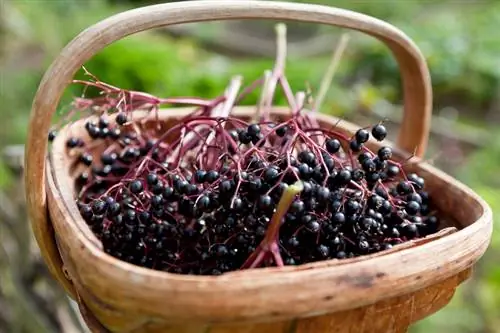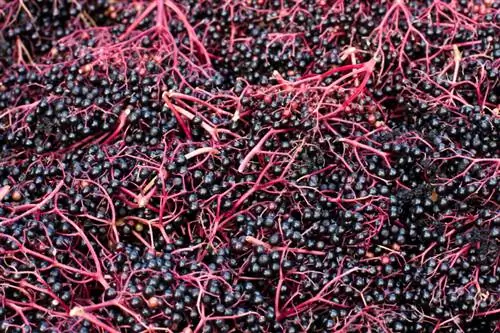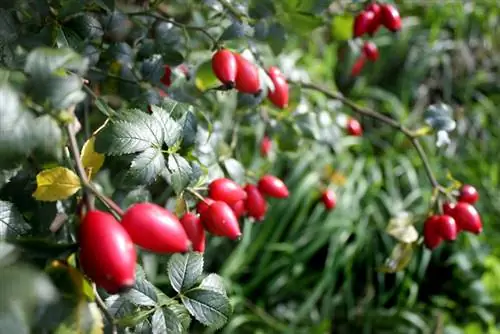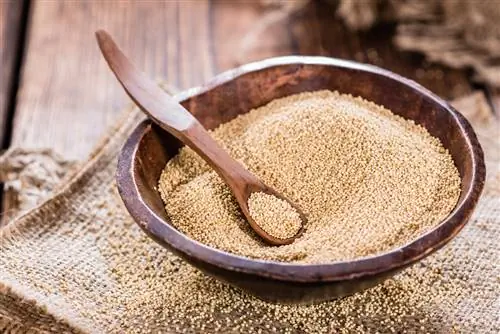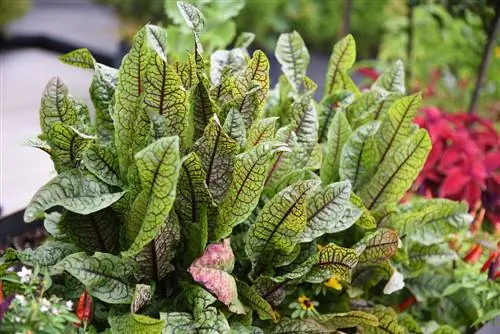- Author admin [email protected].
- Public 2023-12-16 16:46.
- Last modified 2025-01-23 11:20.
They thrive wild on the side of the road or under the caring hand of the hobby gardener. A mystical air has surrounded elderberries for generations. Tart in taste, very he althy, but sometimes poisonous. Immerse yourself in a fascinating diversity here.
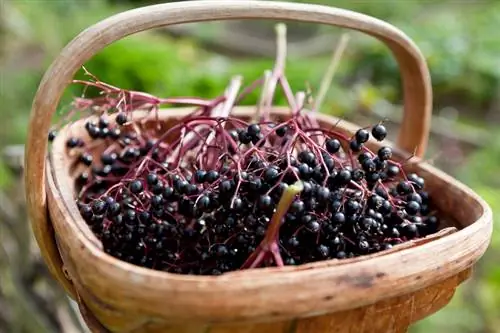
When and how do you harvest elderberries?
Elderberries are ready to harvest from August to September and should be completely colored. When harvesting, cut off the umbels, sort out unripe fruits and wash them. They are poisonous raw, so they must be heated or cooked before eating.
When are elderberries harvested?
In the garden, elderberries are ready to harvest a little earlier than in the wild. The ripening period therefore extends from August to September. The fruits visually indicate their ripeness by being completely colored.
The berries of the black elderberry are purple-black, without any red nuance. The same applies to the fruit of the blue elderberry. The fruits of the red elderberry, known as deer elderberry, no longer have greenish spots.
Which harvesting technique is recommended?
In earlier years, elderberry juice was used to dye clothing, hair and food. It follows that protecting hands and clothing is essential when harvesting. The following procedure has proven successful:
- cut off the entire umbel with the berries using scissors
- sort out unripe fruits using two fingers
- carry the harvest into the house in a basket or plastic tub
- rinse the individual fruit umbels under running water
- Strip the elderberries over a kitchen sieve using a fork
- then stone the red elderberries
Don't be tempted to snack on the raw berries while picking. In the worst case, you will have to pay for it with severe stomach pain and severe nausea. The cause is the content of toxic sambunigrin, which only decomposes when heated.
The most important nutritional values
Elderberries are rich in provitamin A and contain various B vitamins in significant quantities. They also score points with these values per 100 grams:
- 48 calories
- 0.5 grams fat
- 2.5 grams of protein
- 7, 4 grams of carbohydrates
- 4, 0 grams of fiber
How to cook elderberries tasty
Undoubtedly, the fruits of the elderberry have a tart, bitter taste. Hardly any recipe will work without a generous portion of sugar. Since the poison content can only be dissolved by heating, boiling it down to make jam is the most popular preparation. This is how it works:
- Mix 1.5 kilos of washed elderberries with the juice of one lemon
- Stir in 500 grams of preserving sugar evenly
- Bring to the boil in the pot while stirring and continue cooking for 4 minutes
The hot mixture is poured into sterilized screw-top jars, which after sealing must be turned upside down for at least 10 minutes.
Juicing berries for a vitamin kick
If you have a juicer available, the device will quickly transform your fresh elderberries into refreshing, he althy vitamin juice. To do this, fill the lower part of the pot with water and add 400 grams of sugar to the juice collection container. Place 2 kilos of the cleaned berries in the sieve insert. Juicing takes 50 minutes.
About 5 minutes before the end of the procedure, take half a liter of juice and pour it from above over the remaining berries. This way you create consistent concentration. Last but not least, the hot elderberry juice comes in bottles, which are immediately closed tightly. Diluted with mineral water, the juice tastes particularly refreshing.
Freeze properly for a long shelf life
Loving care for elderberries usually results in a bountiful harvest. If not all elderberries can be processed immediately, there may be a certain amount of time pressure. All types of elderberry tend to shed their fruit and leaves in autumn. To bridge the time until preparation, freezing is a practical solution. Here's how to do it:
- freeze the washed berry umbels completely
- alternatively, comb out the fruit with a fork
- pick out unripe and overripe berries
- fill all usable elderberries into freezer bags
In the last step, seal the bags as airtight as possible and put everything in the freezer. By the way, the cold does not decompose the toxic ingredient, so the thawed elderberries have to be cooked before consumption.
Elderberries dry in the oven and dehydrator
The traditional art of drying is coming to the fore again, because no one wants to treat their fruit harvest with chemical preservatives. The small berries of the elderberry are the ideal candidates for preserving them naturally by specifically removing the water.
The plan works in the oven by spreading the washed fruit out on a baking tray. With a top and bottom heat of 50 degrees Celsius, the drying process takes a little longer than circulating air. If you don't want to block the oven for long, use a special dehydrator. This is equipped with a heater, a fan and several sieves. The elderberries are dried at 60-70 degrees Celsius.
Tip
Not only the berries are suitable for consumption, but also elderflowers. Freshly picked and dipped in pancake batter, fry the flowers in pork fat. The regional speci alty is served under the name 'Hollerküchle'.

